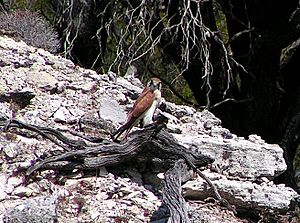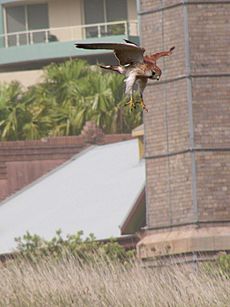Nankeen kestrel facts for kids
Quick facts for kids Nankeen kestrel |
|
|---|---|
 |
|
| In flight | |
 |
|
| Female | |
| Conservation status | |
| Scientific classification | |
| Genus: |
Falco
|
| Species: |
cenchroides
|
The nankeen kestrel (Falco cenchroides) is a type of raptor (a bird of prey) that lives in Australia and New Guinea. It is one of the smallest falcons. Unlike many other falcons, it doesn't rely on super speed to catch its food. Instead, it often sits quietly in an open spot, waiting for prey. It's also famous for its special way of hovering (staying still in the air) over fields and grasslands.
Contents
About the Nankeen Kestrel
The nankeen kestrel belongs to a group of birds called Falco. Scientists Nicholas Vigors and Thomas Horsfield first described this bird in 1827. Its scientific name, Falco cenchroides, comes from old words. Falco is a Latin word for 'falcon'. Cenchroides comes from Ancient Greek words meaning 'kestrel' and 'resembling'. So, its name means 'falcon resembling a kestrel'.
People sometimes call this bird by other names like Mosquito Hawk, Kestrel, Windhover, or Hoverer.
This kestrel is closely related to the Common kestrel from Europe and Asia, and also the spotted kestrel. It's thought that the nankeen kestrel came from common kestrels that flew to Australia a long time ago, less than 1 million years ago. They then changed to fit the local environment.
There are two main types, or subspecies, of the nankeen kestrel:
- Falco cenchroides cenchroides: This type is found all over Australia and Tasmania. It also lives on Christmas Island, Norfolk Island, and Lord Howe Island. Sometimes, it visits southern New Guinea.
- F. c. baru: This type lives in the Snow Mountains in west-central New Guinea.
Physical Description
The nankeen kestrel is a small, slender falcon. It is about 28 to 35 centimeters (11 to 14 inches) long. Its wings can spread out from 66 to 78 cm (26 to 31 in). Male kestrels usually weigh between 121 to 195 grams (4.3 to 6.9 ounces). Females are a bit heavier, weighing from 115 to 273 grams (4.1 to 9.6 ounces).
This bird has light reddish-brown feathers on its back. Its flight feathers (the long feathers on its wings) are black, which stands out. Its belly is mostly white with fine streaks. It also has a black band near the end of its tail. The skin around its eyes and beak, and its legs, are yellow.
Male kestrels have a light grey head and tail. Females and young birds have a light reddish-brown head and a tail with fine bars. Even though their feathers can look a bit messy sometimes, it's easy to spot them. Their slim body, small size, and special way of hovering with straight wings make them unique.
Other birds of prey in Australia that can hover are the elanid kites and the brown falcon. However, elanid kites are much lighter in color and a bit bigger. Brown falcons are much larger and heavier, and they don't hover as easily. The nankeen kestrel looks like a lighter, less patterned, and smaller version of the Eurasian kestrel.
Where They Live and Their Home
The nankeen kestrel is a very common bird of prey. You can easily see it in Australia, New Guinea, and nearby islands. It sometimes visits New Zealand. These birds can live in almost any open area that doesn't have too many dense trees. They especially like grasslands and open woodlands. In the tropical north and sandy deserts, you might see them only at certain times of the year. In Western Australia, they are often seen on coastal cliffs and power lines.
These birds don't have a clear pattern of moving from place to place like some other birds. In the southern grasslands, some pairs stay in the same area all year. But many others fly north during the colder Australian winter. Some even travel across the dry inland areas to find food.
You usually see nankeen kestrels alone or in pairs. But if there's a lot of food, they might gather in groups of up to 30 birds. Pairs usually stay together. They might or might not move to different areas when it's not breeding season.
For their nests, they use any handy spot. This could be a hollow in a tree, a ledge on a cliff, or an old nest built by another bird like a crow. The kestrels don't add anything to these nests.
What They Eat and How They Hunt
Nankeen kestrels eat many different things. Their diet includes a lot of insects. They also eat small birds, reptiles, and especially small rodents like mice.
These kestrels are very good at changing how they hunt. The most common way they hunt is by sitting on an exposed spot. This could be a dead tree or a telephone pole. From there, they watch for prey. But their most famous hunting method is hovering perfectly still over fields and grasslands. This allows them to spot their next meal from above.
Reproduction and Life Cycle
Nankeen kestrels usually lay three to seven eggs in late winter, with about four eggs being common. Only the female bird sits on the eggs to keep them warm. This is called incubation, and it takes about 26 to 28 days for the eggs to hatch.
While the female is incubating, the male brings her food. After the chicks hatch, the female continues to stay with them. She keeps them warm until they are almost ready to fly. Then, she also leaves the nest to hunt for food for her young. If there is plenty of food, these kestrels can raise more than one group of chicks in a good season.
See also
 In Spanish: Cernícalo australiano para niños
In Spanish: Cernícalo australiano para niños




